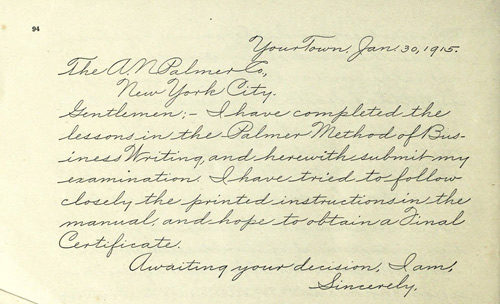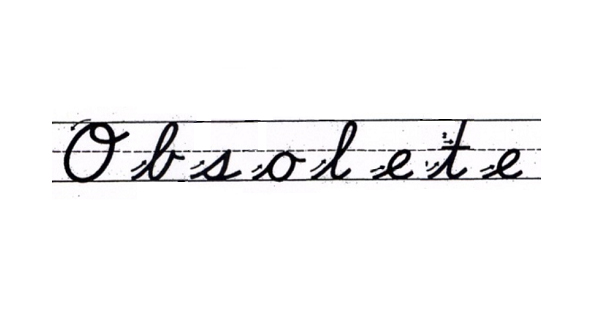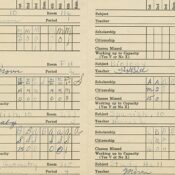
I learned cursive handwriting in the second grade — concurrently with learning that Santa Claus was a hoax. The first word I learned to write in the august script was “Christmas.” Like a streaming ribbon across the page, the word was beautifully connected, seemingly designed to be written in one epic, fluent stroke. I scrawled a cursive “Christmas” on everything — notepads, used envelopes, a toy magnetic drawing board — like it was my own signature.
This was in the late ’90s, when the D’Nealian method of handwriting offered a smooth transition to cursive learning by way of small “tails” at the ends of t’s and i’s that would, supposedly, nudge students toward polished, fluid script. I took these tails to their elaborate limits, forming an ostentatious descender from my name’s “N” that wrapped around the word to form the tittle above the “i,” sometimes as a flower or an exploding firework. My indulgence in an ornate signature throughout grade school was an imitation of my mother’s own dramatic autograph.
I imagine such a personal connection with cursive handwriting must be prevalent among other adults who remember a time before touch screens. Cursive seems to be linked, for many, to intellectual competence, identity, and even morality in the age of its decline. We can’t imagine a functional future that doesn’t include pretty writing. But, more importantly: how could our children be deprived of the exact grueling tradition of penmanship education through which we all had to suffer?
Our attachment to attached letters is rooted in our national identity. Cursive handwriting has a long, rich history in the U.S., from the copperplate lettering of the Declaration of Independence to the Spencerian script of the Coca-Cola logo. Author Anne Trubek has documented this, most notably in The History and Uncertain Future of Handwriting. The 19th century cursive school of Platt Rogers Spencer was flowery and elegant, based on the natural forms of trees and leaves, while the 20th century gave way to A.N. Palmer’s industrial age style, characterized by more rugged, efficient strokes. In a Pacific Standard article, Trubek writes, “Handwriting slowly became a form of self-expression when it ceased to be the primary mode of written communication. When a new writing technology develops, we tend to romanticize the older one. The supplanted technology is vaunted as more authentic because it is no longer ubiquitous or official.”
In 2010, the Common Core standards — detailed educational objectives encouraged by the U.S. Department of Education — omitted cursive writing from its curricula, declaring instead that students in kindergarten and first grade should learn to write in print proficiently before swiftly moving on to the keyboard. This has resulted in a years-long, nationwide debate over the usefulness of cursive script. In Indiana — one of eight states to opt out of Common Core standards — the fight for cursive is renewed each year by State Senator Jean Leising, who regularly puts forth a bill to require cursive in Indiana elementary schools. Leising notes the popularity of mandatory cursive, citing an Indiana Department of Education survey of 4,000 educators that showed 70 percent support, and rejects skeptical claims that cursive script is not a 21st-century skill. As the Indianapolis Star pointed out, Indiana Governor Eric Holcomb writes his own signature in print.
The backlash against cursive’s obsolescence has taken both melancholic and wrathful tones. In 2015, a Facebook post showed a teacher’s reprimand of a supposed 7-year-old’s cursive signature on a homework assignment: “Stop writing your name in cursive. You have had several warnings.” The post was shared over a million times and drew comments from many claiming it was a clear indicator of everything wrong with education and, perhaps, society in general. We’ve all seen mournful accounts of graduate students who can’t read historic documents or a parent’s lament that letters sent to their child’s summer camp were unappreciated. And they are in good company with the army of capitalized Facebook comments declaring cursive’s extinction “RIDICULOUS !!!” But is it?

Opinions on the usefulness of cursive sometimes focus on aspects of security: children “should, at the very least, learn their signature” or else they could be vulnerable to forgery. Marvin Sumner, a professor emeritus of Developmental Psychology at Western University, says forgery is indeed more difficult with cursive because there is “a more complicated series of motor movements involved than with block letters.” That said, the argument might be ignoring the reality of signatures in the 21st century in the first place. The familiar index-finger scribbles on coffee shop iPads hardly resemble a Spencerian autograph, and many important tasks, like filing taxes or “signing” a lease, no longer require a handwritten signature at all.
The motor movements involved in handwriting are at the heart of its benefit, whether the writing is cursive or print. Simner notes that devoting attention span to learning the construction of letters adds the motor component to visual and aural learning of language. In the Times, Maria Konnikova writes, “children not only learn to read more quickly when they first learn to write by hand, but they also remain better able to generate ideas and retain information.” Since cursive is thought to be faster, its adherents probably experience swifter and more coherent thought processes than printers, right?
The only problem is that cursive isn’t faster. In “Cursive Handwriting and Other Educational Myths,” Nautilus points to a 2013 study comparing the writing speeds of cursive French students and their printing Canadian peers. It found that, overall, cursive was slower than block print, “but fastest of all was a personalized mixture of cursive and manuscript developed spontaneously by pupils around the fourth to fifth grade.” If it isn’t more efficient, why are we perpetually trying to revive the corpse of cursive, anyway?
Could it be that the fine motor skills and neural pathways created during our taxing repetitions of loops and letterforms were accompanied by a sort of chirographic Stockholm syndrome? That we can only purge our obsessive devotion to curlicues and connected letters by passing it on to our young? With so many cursive enthusiasts in this country, you would think calligraphy was a much more universal hobby.
Like the Canadian students in the 2013 study, my own writing became a combination of print and cursive at some point in junior high. In my own signature, I traded the stylized “monkey’s tail” of a cursive “N” for a printed one with a final ascender that leaps off the page as if to say “block print can be exciting too!” When I am in the checkout line at the grocery store, however, I scratch in a sordid squiggle like everyone else.
Become a Saturday Evening Post member and enjoy unlimited access. Subscribe now




Comments
In the raging debate of whether to teach cursive or print, there is a middle ground that Mr. Gilmore fails to mention: italic handwriting.
“Cursive” simply means connected or flowing writing. (There has been cursive writing as early as the ancient Egyptian Demotic script from the 3rd century BCE.) Yes, one form of cursive is the loopy, frilly Palmer style that was later made more user-friendly for education by Zaner-Bloser and others, then adapted by Donald Neal Thurber in his D’Nealian scrip. D’Nealian was touted as a breakthrough, because it presented a way for children to learn “pre-cursive” writing — using the cursive letterforms but not connect. Ultimately, all these styles have the same issues: 1) one must learn two two alphabets (print and cursive forms) that are not interchangeable, 2) they contain loops and exaggerated stokes that make it difficult to teach and read.
Indiana State Senator Jean Leising has introduced her cursive mandate many times without success, and it has been demonstrated that her stated reasons for the bill do not accurately reflect research.
Italic handwriting, on the other hand, is cleaner (no loops), easier to learn (print and cursive letterforms are identical), and adaptable (one can move easily from print to cursive by subtracting or adding joins). Italic has been in use since the first handwriting instruction book in 1522. It was repopularized in modern times by Edward Johnston (who is also credited with designing the first sans-serif type). Italic is gaining interest in the US, most notably in homeschools, as a practical alternative to looped cursive that saves classroom time. Many adults (including doctors) have adopted it as a quick handwriting style that doesn’t break down under pressure.
I encourage adults to use whatever handwriting (and signature style) they choose. But when it comes to mandating handwriting instruction, it’s a mistake to require “cursive”. Instead, let’s do pay attention to peer-reviewed research that suggests that a) handwriting instruction is important for literacy, compositional skill and note taking, b) the fastest handwriting is one that mixes print and cursive styles as the student chooses, and c) 60% of students who are taught conventional looped cursive abandon it by the time they enter high school.
Everyone really needs to read the ‘prequel’ to this feature from last month: “7 Reasons to Keep Writing Letters” (search bar) before or after this one.
I learned handwriting in the 2nd grade also, with the capital and small letters above the chalkboard. There was also the copy of the Declaration of Independence in a glass frame on the wall. I REALLY wanted to learn how to write like that, and didn’t mind practicing at all. My Mom had beautiful handwriting and I seemed to inherit that. I recently sent out Christmas cards and it wasn’t so hot because it was a rush job this year, and my eyes were burning from the fires; but it was still okay.
In your third paragraph you speak of children suffering to learn handwriting. I’d never heard of that before. Math, science, geography yes, but that surprised me.
Let’s just get down to the nitty-gritty. Just because we have touch screens now, and seemingly less occasion to use handwriting, doesn’t mean it shouldn’t be taught, or that it’s obsolete. The POST comes out 6 times per year, at one time it was 52. Does that make it obsolete? Of course not!
The backlash against its perceived obsolescence is a good thing. That cursive was shown to be slower writing speed than printing by that French Canadian study seems really off. Handwriting is faster once you know how, than printing, but it also depends on the person.
I’ve been forced myself to do the sordid squiggle when signing on screens. It’s an important motor skill to have, that’s unique to YOU only. You should know how to write notes and letters regardless of tech. Tech has sucked the life out of too many things as it is, now it’s taking away something as personal as your ability to write other than printing? Handwriting is also something that is human and friendly. It was used in advertising for many years to make the product that much more appealing. The loss of cursive is just one more aspect of the U.S. becoming a lowest common denominator nation.
All the music sounds alike, the cars all look alike, the movies (almost) all look alike, and now, so does everyone’s forge-able signatures. Sad and dangerous. I dare anyone to tell me the Coca-Cola logo is obsolete, and/or could be improved on.